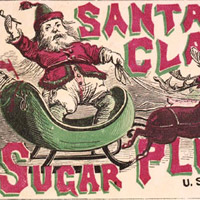 |

聖誕老人甜葡萄乾:這是特別的節慶糖果 (1868年)

|
 |
|
 |
聖誕節 (Christmas
Day) :12月25日
西元前336年,羅馬的基督教教堂在12月25日當天慶祝聖誕節。就在這一天,羅馬人也慶祝農神節 (Saturnalia) ,也就是冬至 (winter
solstice,一年之中最短的一天) 。為了慶祝,羅馬人互相交換禮物,並且用盛宴來表示歡愉的心情。在羅馬新年時 (1月1日) ,人們會用綠葉來裝飾自己的房子,並且發送禮物給自己小孩子和窮苦的人。萬年青是生存下來的一種象徵。
現代的聖誕節就援引了許多傳統習俗。聖尼可拉斯 (St.
Nicholas) 從11世紀開始就成為很受歡迎的聖誕節人物,他相當慷慨大方,而且還有治癒、撫慰人心的力量。後來因為新教勢力的興起,人們幾乎要忘記這個人了。不過,荷蘭人卻把聖尼可拉斯稱為
「Sinterklass」。這個名字聽起來是不是很熟悉呢?
By 336 A.D., the Christian church in Rome celebrated the festival of Christmas on December 25. The same day, Romans celebrated Saturnalia, the winter solstice (the shortest day of the year). In observance of the "birthday of the unconquered sun," they exchanged gifts and made merry with a festival. On the Roman New Year (January 1), people decorated houses with greenery and gave gifts to children and the poor. Evergreens were a symbol of survival.
Modern-day Christmas borrows many of these traditions. St. Nicholas became a popular figure by the 11th century, known for his great generosity and healing powers. With the rise of the Protestant Church, he was nearly forgotten, except in the Netherlands, where they called him Sinterklaas. Does that name sound familiar?

 2/4 頁
2/4 頁

|





